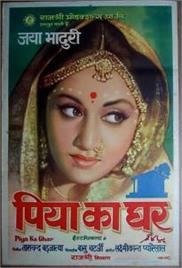Be Careful of Fake Websites. Always use HindiMovies.to domain & Join our Telegram Channel for Latest Updates.

Likes: 22
Views: 2.88K
Malti Shankar lives in a fairly large house in a small town in India with her mom and dad, while her paternal uncle, Gauri Shankar, who has literally brought Malti up, lives in the house next door. Malti’s marriage is being arranged with a young man named Ram G. Sharma, who lives in Bombay with his dad, Girdharilal; mom; elder brother, Shiri and his wife, Shobha; and a cricket-crazy school-going brother, Hari. The Pandit, arranging the marriage, describes the Sharma family, who originate from the nearby Bayana town, as a good family, living near the seashore, in a big building called “Bharat Mahal”. The wedding party arrives, the bride and groom approve of each other, get married, and Malti re-locates to Ram’s house. She is shocked and surprised to find that it is nowhere near the seashore, is a shanty room, divided two ways, and a kitchen – that is now her bedroom. Malti always had lots of space to live and grow up in, will this obscure, noisy, overcrowded, with virtually no privacy for herself and Ram – be her fate for this lifetime? What will Gauri Shankar’s reaction be when he finds out the reality of the Sharma family?
Released: 1972
IMDb Rating: 6.8/10 (113 Votes)
Genre: Drama, Family, Hindi Movies, Musical
Stars: Agha, Anil Dhawan, Asrani, Jaya Bhaduri
Directors: Basu Chatterjee
Writers: Ram Kelkar, Basu Chatterjee, Vasant P. Kale
Year: 1972
Server 1 – Youtube
Server 2 – Youtube
Piya Ka Ghar (1972): A Heartwarming Tale of Family, Love, and Urban Struggles
Introduction
Piya Ka Ghar, released in 1972, is a classic Bollywood drama that beautifully encapsulates the everyday trials, tribulations, and tender moments of a middle-class family trying to carve out a life amidst the hustle and bustle of Mumbai. Directed by the esteemed Basu Chatterjee and featuring prominent performances by Anil Dhawan and Jaya Bachchan, the film weaves a poignant narrative filled with humor, emotional depth, and relatable family dynamics. This musical drama remains a memorable work for its realistic portrayal of urban Indian life and the importance of familial bonds.
Plot Summary
The story of Piya Ka Ghar centers around Amar Saxena (played by Anil Dhawan) and his wife Malti (portrayed by Jaya Bachchan), a newlywed couple who move into a cramped one-room apartment with an extended joint family in the crowded city of Mumbai. The film delves into the everyday challenges and compromises involved in living in such restricted spaces, especially when shared by multiple family members. The story humorously and sensitively explores how love, patience, and understanding become essential tools for survival and happiness in such a close-knit environment.
As Amar and Malti adjust to their new life, the film sheds light on the larger urban reality faced by many middle-class Indian families of the era — the struggle for privacy, the clash of individual aspirations versus collective responsibilities, and the warmth derived from family solidarity. Basu Chatterjee's direction offers a slice-of-life experience, focusing more on characters and their interpersonal relationships than on extravagance or melodrama.
Main Actors
The supporting cast includes seasoned actors like Satyen Kappu, Preeti Ganguly, and others, who contribute layers of authenticity and humor, enriching the narrative with varied family dynamics and perspectives.
Director and Writer
Piya Ka Ghar is directed by Basu Chatterjee, a respected filmmaker renowned for his realistic and relatable storytelling style. Basu Chatterjee was instrumental in shaping the middle-of-the-road cinema (MOR) movement in Bollywood, which focused on middle-class stories with simplicity and nuance. His films often steer clear of excessive melodrama and instead focus on believable characters and everyday situations.
The screenplay and dialogues were also crafted under Basu Chatterjee's guidance, with keen attention to detail and character development. The writing highlights subtle comedy interwoven with poignant drama, giving a layered storytelling experience.
Music and Songs
Being a musical drama, Piya Ka Ghar boasts a delightful soundtrack that complements its narrative beautifully. The music was composed by the legendary R.D. Burman, whose melodic range and innovative sound continue to enthrall audiences even decades later.
The songs in the movie are thoughtfully integrated into the story, enhancing the emotional landscape and the cultural context. Some of the notable songs include:
The lyrics, penned by Yogesh, are poetic yet grounded, echoing the film’s themes of love, family, and resilience. The musical score richly supports the film’s mood, making every emotional beat resonate more deeply.
Impact and Legacy
Piya Ka Ghar holds a significant place in Bollywood history as an insightful and affectionate portrayal of joint family life in urban India. It films a canvas familiar to many but often overlooked in mainstream cinema, especially during the early '70s. The film’s balanced combination of drama, comedy, and music underlines universal themes of compromise, understanding, and affection, making it timeless and relatable across generations.
The collaborative brilliance of Basu Chatterjee's directorial sensibilities, the earnest performances of Anil Dhawan and Jaya Bachchan, and the evocative music by R.D. Burman create a cinematic experience that is both entertaining and thought-provoking.
Conclusion
In sum, Piya Ka Ghar (1972) is a cinematic gem that explores the nuances of family life against the backdrop of a crowded city. Its engaging storyline, heartfelt performances, talented direction, and memorable music combine to deliver a film that resonates with audiences seeking stories rooted in reality yet filled with hope and human warmth. For fans of classic Hindi cinema, and anyone interested in human stories about family and societal ties, this movie remains a must-watch.